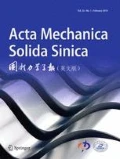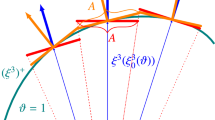Abstract
In the process of shale gas exploitation, there exits two difficult problems: one is the real numerical simulation of a tremendous number of holes in actual shale; the other is the fluid–solid coupling problem involved in holes, where the difficulty of transition at the interface between the Eulerian grid and the Lagrangian grid becomes the most important. In response to these two problems, this paper establishes an element model with both fluid and solid. At the fluid–solid interface, the equilibrium condition of the surface force is introduced to obtain the modified complementary energy functional, and a new hybrid stress element with fluid is derived. The comparison of the simulation results with those of the ordinary commercial finite element software verifies the effectiveness and efficiency of this element, and proves its applicability in the problem of shale with numerous holes. Furthermore, this element can be extended to general problems of solid with fluid in.


















Similar content being viewed by others
References
He T. Overview and analysis of numerical methods for fluid–structure interaction. Vib Shock. 2018;37(4):184–90. https://doi.org/10.13465/j.cnki.jvs.2018.04.028.
Cen S, Wu CJ. Some advances in high-performance finite element methods. Eng Comput. 2019;36(8):2811–34.
Wang L, Chen J-S. Subdomain radial basis collocation method for fracture mechanics. Int J Numer Methods Eng. 2010;83:851–76.
Pian THH. Derivation of element stiffness matrices. AAIA J. 1964;2(576):577.
Accorsi ML. A method for modelling microstructural material discontinuities in a finite element analysis. Int J Numer Methods Eng. 1988;26(2187):2197.
Accorsi ML, Chamarajanagar R. Numerical validation of a hybrid finite element method using eigenstrain. Comput Struct. 1991;41(5):1065–71.
Zhang R, Guo R. Voronoi cell finite element method for fluid-filled materials. Transp Porous Med. 2017;2017:1–13.
Han N, Guo R. Two new Voronoi cell finite element models for fracture simulation in porous material under inner pressure. Eng Fract Mech. 2019.
Pian TH-H. Selected Papers on Finite Element. Beijing: National Defense Industry Press; 1980. p. 291–3.
Acknowledgements
This work was supported by the National Natural Science Foundation of China (Grant Nos. 11572142 and 12072135).
Author information
Authors and Affiliations
Corresponding author
Rights and permissions
About this article
Cite this article
Qiu, Y., Guo, R. & Wang, T. A New Hybrid Stress Element with Fluid. Acta Mech. Solida Sin. 34, 766–778 (2021). https://doi.org/10.1007/s10338-021-00242-y
Received:
Revised:
Accepted:
Published:
Issue Date:
DOI: https://doi.org/10.1007/s10338-021-00242-y




